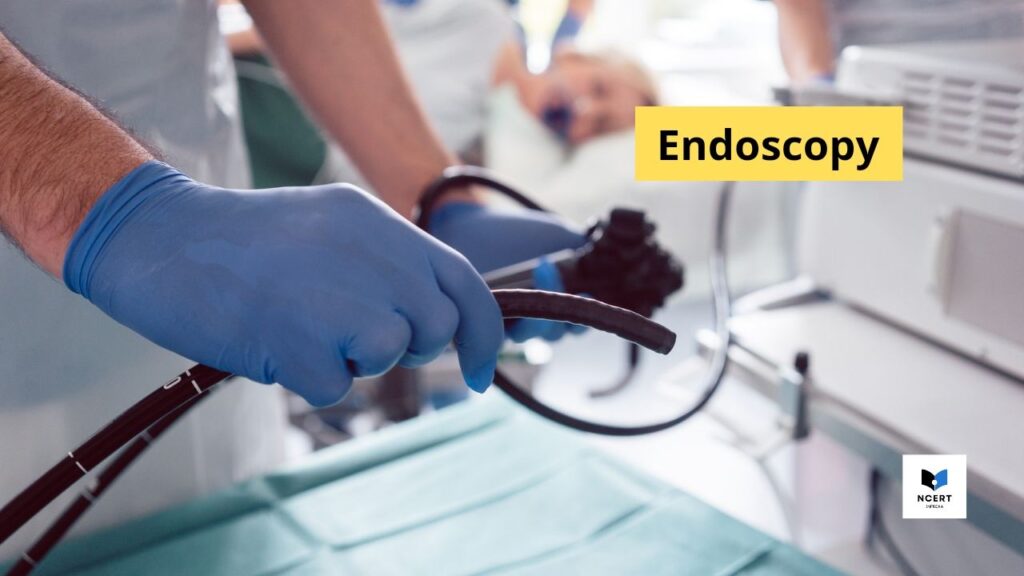Endoscopy is such a test procedure, with the help of which the internal organs and vessels etc. of the body are seen and operated on them.
A special instrument is used in this procedure to see the internal organs of the body. With the help of this instrument, internal organs can be seen without making any major incisions inside the body.
What is Endoscopy
Endoscopy is a procedure in which the internal organs of the body are examined using an instrument called an ‘endoscope’.
An endoscope is a long, thin, flexible tube with a light and a camera at one end. The pictures taken with the help of the camera are sent to the computer screen.
There are many different types of endoscopy. Below are the names of some types of endoscopy and where they are used etc.
- Arthroscopy – for the joints
- Bronchoscopy – for the lungs,
- Colonoscopy and sigmoidoscopy – for the large intestine,
- Cystoscopy and Ureteroscopy – for the urinary system,
- Laparoscopy – for the abdomen and pelvis,
- Upper Gastrointestinal Endoscopy – for the esophagus and stomach.
What is the purpose of Endoscopy
Endoscopy is used to:
- To investigate unusual symptoms,
- To help perform a particular type of surgery,
- With the help of endoscopy, a sample of tissue can also be removed from the body, which is analyzed,
- To test for and treat bleeding inside the abdomen,
- To find the cause of malabsorption in the digestive tract,
- Endoscopy may also be used to confirm problems with the small intestine visible on X-rays.
- During surgery, endoscopy is used to locate and drain the wound with minimal damage to healthy tissue.
- To monitor and prevent cancer, for example, doctors use an endoscopy procedure called colonoscopy to monitor colon cancer.
- To investigate and diagnose the causes of disease symptoms. The type of endoscopy chosen by the doctor depends on the part of the patient’s body that needs to be examined.
Along with the above, it is used in the following treatments:-
- Performing surgery with the help of a small incision, which is called laparoscopic surgery.
- Laser therapy, in which powerful beams are used to destroy cells.
- Photodynamic surgery, in which a light-sensitive substance is injected into the tumor and then it is destroyed with the help of laser.
Before it
Endoscopy is usually done in the hospital itself. There may be some types of endoscopy that require more preparation before starting the procedure.
For example, depending on the part of the body to be tested, the patient may need to abstain from eating and drinking before the endoscopy.
The doctor also advises the patient about how long before the procedure begins to abstain from food and whether the patient can consume liquids or abstain from them.
If a colonoscopy test is to be done in the large intestine, the doctor may give the patient a laxative (laxative pill) before the procedure, which clears the stool from the intestines.
If patients are already taking any type of medication, they may have to stop taking the drug or change the time of the medication for a limited period of time before the procedure begins.
However, the medicines should not be stopped without consulting the doctor and unless the doctor tells them to stop them. Some people also need to take antibiotics before the endoscopy procedure.
During this
This procedure does not require an overnight stay in the hospital, as the procedure takes only up to 1 hour to complete.
The endoscopy procedure is usually not painful, some people may experience mild discomfort during it (a sore throat or sore throat).
Endoscopy is usually done in the conscious state of the patient. A local anesthetic is given to numb a specific area. This is usually in the form of a spray or lozenge to numb the throat.
Sedatives may be given to make the patient feel relaxed so that the patient is less aware of what is happening around him.
The endoscope is very carefully inserted into the patient’s body, the endoscope is sent exactly where the test is to be performed.
For example, it can be put in the following parts of the body –
- Neck
- Anus – The stool from the anus is first expelled from the body.
- Urethra – First urine is removed from the body.
After Endoscopy
After the endoscopy, the patient should rest for at least 1 hour continuously, because by doing this the effect of the medicines given for sedation etc.
In most cases, the patient is kept under observation for an hour or more.
If the patient has been given a medicine like a general anesthetic, then he is kept under observation for a long time.
Painkillers are also given to the patient if needed.
If the effect of sedative drugs persists, the patient may need a companion to transport the patient from the hospital to the home.
If endoscopy has been used to examine the bladder, the patient may have blood in the urine for up to 24 hours after the test procedure.
It gets better on its own, but if you are still experiencing this problem after 24 hours, then you should talk to the doctor about it.
What are the risks of Endoscopy?
Endoscopy is generally a safe procedure and the risk of serious complications is low.
Possible complications include –
- Infection in the part of the body that was examined by endoscopy – this may require treatment with antibiotics.
- Perforation or excessive bleeding of internal organs – Surgery may also be needed to repair the damaged organ or tissue. Sometimes a blood transfusion is also needed.
- Hemorrhage
- Allergic reaction to anesthesia
- Over-sedation – however, sedation is not always necessary.
- Feeling bloated for some time after the test procedure.
- The local anesthetic causes the throat to remain numb for a few hours after the procedure.
If any of the following symptoms are felt, then immediately the doctor should be informed about it –
- Dark or black stools
- Breathlessness
- Persistent severe abdominal pain
- Pain in chest
- Vomiting blood
What do endoscopy results mean
Normal Result
In the endoscopy result of a healthy person, there is no change in his body structure and organs.
Abnormal Result
Changes in the endoscopy image such as swelling, ulcers, and tumors may indicate abnormal results. This includes –
- Bloody ulcer
- Cancer
- Urinary tract infection (UTI)
- Urinary tract stones
- Irregular bowel movements
It depends on the patient’s situation when the endoscopy results are received. For example, if a doctor uses endoscopy to examine an ulcer, the result may be known soon after the procedure is done.
If endoscopy is used to take a tissue sample (biopsy), it may take a few days to get the results. You can also talk to the doctor about the time taken to get the result of the endoscopy.
When to get Endoscopy
Some of the symptoms that endoscopy is often used to check for are:
- Difficulty swallowing (Dysphagia)
- Persistent abdominal pain,
- Chest pain that is not caused by any heart disease.
- Persistent nausea and vomiting,
- Weight loss (for which reason is not clear
- Vomiting blood,
- Persistent diarrhea,
- Blood in stool etc.




